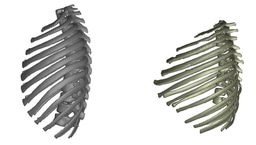Gallery | Homo erectus versus modern humans frontal breathing mechanics.
Published in Ecology & Evolution
Animated breathing motion of the ribcages of the Turkana Boy (KNM-WT 15000; Homo erectus; left) and a modern human (right), both shown in frontal view. We used the same ranges of motion in both rib cages, but the shape of the ribs and vertebrae in Homo erectus produce a different kinematic pattern, with lesser rib elevation, than in modern humans. Licence CC-BY-NC-ND 4.0; Copyright Benoit Beyer.
See: Behind the Paper post
Follow the Topic
-
Nature Ecology & Evolution

This journal is interested in the full spectrum of ecological and evolutionary biology, encompassing approaches at the molecular, organismal, population, community and ecosystem levels, as well as relevant parts of the social sciences.
Related Collections
With Collections, you can get published faster and increase your visibility.
Understanding species redistributions under global climate change
Publishing Model: Hybrid
Deadline: Jun 30, 2026

Please sign in or register for FREE
If you are a registered user on Research Communities by Springer Nature, please sign in
Thanks a lot for this. The very wide & large thorax of Turkana Boy is not unexpected: most if not all archaic Homo had very large thoraxes, not for running long distances as often assumed, but rather for collecting shallow-water foods such as shellfish (rich in brain-specific nutrients, e.g. DHA). Turkana Boy fossilized in former lake, where they not only waded bipedally but also regularly dived for shallow-aquatic foods, for scientific references google e.g. "coastal dispersal of Pleistocene Homo 2018 Verhaegen".